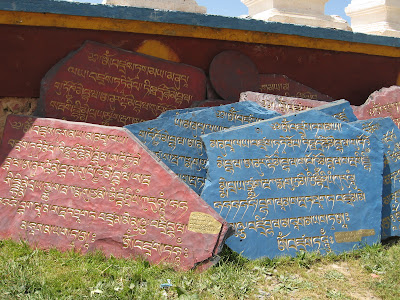Where have I been for the last million years? Not doing anything terribly interesting. It's been a similar drill to what I did last time- teaching and getting into trouble in Wuhan. All of that would have qualified as reruns on this blog, so generally I haven't had much to post here.
That was supposed to change in early July, when the semester ended and I planned to explode out of here like a rocket. Originally I had scheduled two weeks for a stay at Labrang, studying Tibetan language and generally enjoying a break from the Wuhan heat. That plan was absolutely demolished by my school, which in a fit of complete and utter stupidity apparently failed to file any of my paperwork appropriately, and thus consumed 5 straight weeks in an ongoing legal imbroglio. Bribes were issued, paperwork was dispatched by the mountainfull, some other stuff happened that I'm not going to talk about on the internet, but for a while there no end was in sight.
Months ago 3 good friends from DC had bought tickets to come and visit Dennis and Dianne and I this summer. It almost got to the point where I would have missed them in addition to the entirety of my planned Labrang trip, but at the last minute the clouds parted and I grabbed a plane ticket, arriving in Chengdu the night before we were all scheduled to head up into the mountains. Just in time!
Our trip started in Chengdu, capital of Sichuan province. I visited it with Carlos Froman four years ago, and actually had little interest in doing it again at the moment. The objective was to get out of the big city as soon as possible, to see the Tibetan region of Kham which takes up roughly half of Sichuan.
To briefly explain Kham- Tibet has traditionally had three provinces. U-Tsang is what China today calls Tibet Province, but the other two (Amdo and Kham) have been cut up and distributed throughout Qinghai, Gansu, Sichuan, and Yunnan provinces. Kham is every bit as Tibetan as Lhasa- perhaps more so, given that Beijing hasn't bothered to Sinify it yet. It's also a lot easier to get in because unlike Lhasa you don't need a special permit, and it's a LOT cheaper.
The first leg of our trip was from Chengdu to Kangding, the traditional gateway to Kham. The transition, from Chinese to Tibetan, is so slow you barely notice it. Over the course of the 8.5 hour bus ride the landscape changes from the relatively flat Sichuan basin to incredibly high peaks. In one town you see one store with a sign in Tibetan, in the next town there are two, and then half of the stores have them, and by the time you reach Kangding they almost all do. Prayer flags change from being the sign of a Tibet shop to being a ubiquitous feature on every bridge, home, and peak.
Kangding itself was a nice enough town, stretching along both sides of the Dar River which gives the town its Tibetan name, Dardo:

In Kangding we stayed at the Zhilam hostel, which is easily one of the best hostels I've ever stayed in. Located in a village above the town proper, it's very comfortable and the staff was very hospitable. Their recommendation of a hike made the entire stay worthwhile. You see, Kangding is famous for Mt. Paoma, which inspired a popular Chinese love song and is probably the largest single tourist attraction in town. The hostel staff advised that we skip it, though, and take a hike straight up the mountain behind the hostel itself. It would be more difficult, they warned, but a) free and b) much more scenic, with a grassland at the top. Sold!
On starting the hike, we immediately felt that altitude. The first leg took us up to a huge formation of prayer flags on the lower peak of the mountain:

The flags stretched into the woods, which incongruously hosted a random collection of cows and horses:

About two hard hours later we approached the top, with a nice view of the town below:

At this point the path leveled out, taking us the rest of the way to the grassland:

The grassland itself, with a bunch of horses. A really pleasant, almost alpine place, well worth the battle to get there:

After descending we went to a Tibetan restaurant and ordered a few plates of momos, Tibetan dumplings, and fried wild greens. A feast! Tomorrow: the ride to Lhagang.















































